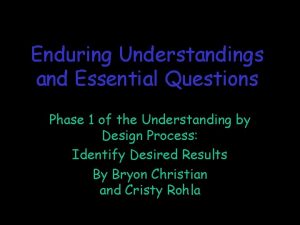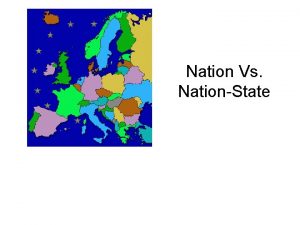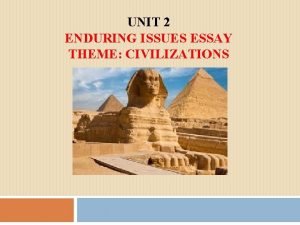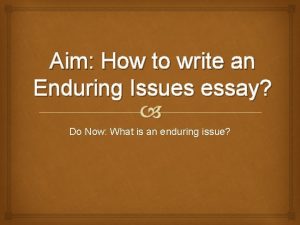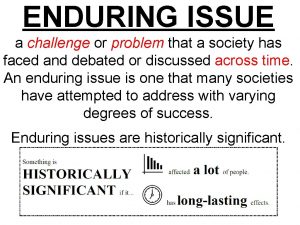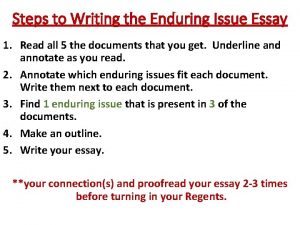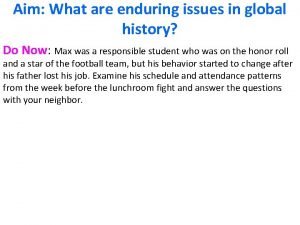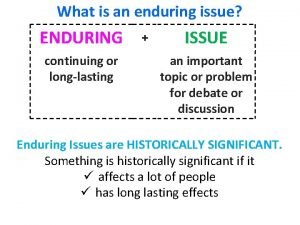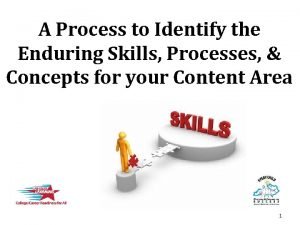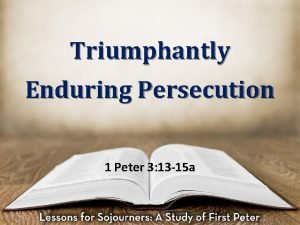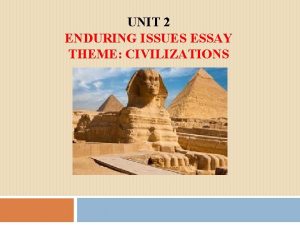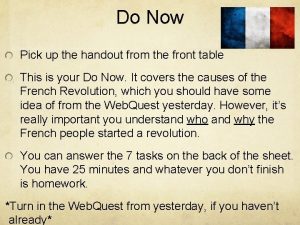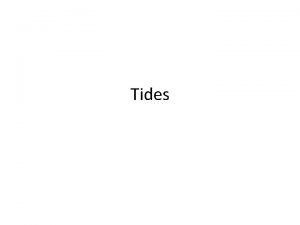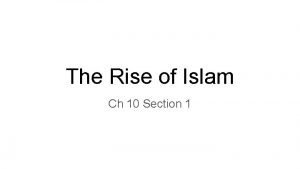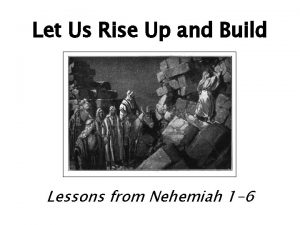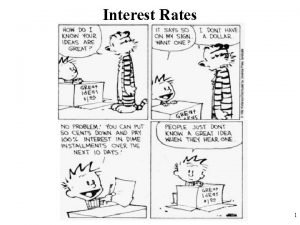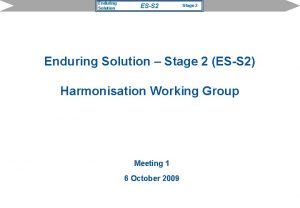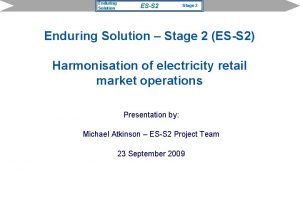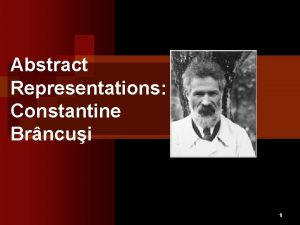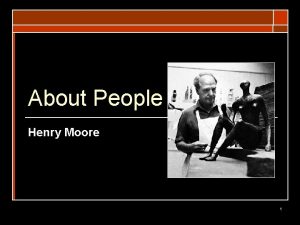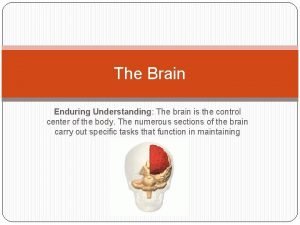Enduring Understanding III Rise of a Nation Students















































- Slides: 47

Enduring Understanding III Rise of a Nation: Students will Investigate the similarities found in the causes, courses, and consequences of the rise of the United States of America. They will be able to recognize these three themes through a study of Colonial Conflict, the Revolutionary War and the foundations of government. III. 5 What key battles happened during the 1 st half of the Revolutionary War: 1775 to the winter of 1777 at Morristown? Who was involved, what occurred, what was the impact? Lexington and Concord Battle of Bunker/Breed’s Hill Dorchester Heights Battle of Long Island Battle of Trenton Inst 17/ 9 Qz/ 55 (35) fm

a. b. c. d. e. f. g. h. i. j. Lexington and Concord Battle of Bunker/Breed’s Hill Dorchester Heights Battle of Long Island Battle of Trenton Battle of Brandywine Battle of Saratoga Winter Encampment at V. F French & Spanish entry Yorktown Inst 17/ 9 Qz/ 55 (35) fm

2 nd Continental Congress, 1776 - 77 Acting Government during the war • Formally declared war via the Declaration of Independence in July of 1776. • Wrote the Articles of Confederation (1 st Government) • Opened diplomatic negotiations with European powers Inst 17/ 9 Qz/ 55 (35) fm

Assessment 1 • This famous painting of Washington crossing the Delaware is a depiction of which battle of the Revolutionary War? – – A. B. C. D. Battle of Lexington & Concord Battle of Trenton Battle of Brandywine Battle of Princeton Inst 17/ 9 Qz/ 55 (35) fm

Assessment 2 • Which of the following paragraphs best describes the Battle of Brandywine fought during the Revolutionary War? – A. This battle was held in December of 1775. American revolutionaries tried to capture a major Canadian city and gain French Canadian support for the American Revolutionary War. The battle put an end to any hopes of French Canada rising in rebellion with the Americans. – B. This battle took place on December 26, 1776. George Washington led the main Continental Army across the river to surprise and virtually eliminate the Hessian garrison in, New Jersey. This boosted the attitudes of the American soldiers. – C. This battle was fought in New Jersey, on January 3, 1777. In the night General Washington's army silently slipped away from Lieutenant General Charles Cornwallis and his troops. This battle cost the British some 276 men killed, wounded or captured and greatly boosted the attitudes of the Continental troops. – D. This Battle was fought on September 11, 1777, near Chadds Ford in Pennsylvania. The battle was a major victory for the British and enabled them to capture the city of Philadelphia Inst 17/ 9 Qz/ 55 (35) fm

Assessment 3 • Which of the following locations is the site of the camp of the American Continental Army during the American Revolutionary War in the winter of 1777 -1778? At this location, there was great suffering for George Washington’s Army; however, it was also a time of re-training and rejuvenation. – – A. B. C. D. Lexington & Concord Brandywine Valley Forge Trenton Inst 17/ 9 Qz/ 55 (35) fm

Morristown Winter Encampment 1776 -1777 Inst 17/ 9 Qz/ 55 (35) fm

Morristown Winter Encampment 1776 -1777 • “THESE are the times that try men's souls. The summer soldier and the sunshine patriot will, in this crisis, shrink from the service of their country; but he that stands by it now, deserves the love and thanks of man and woman. Tyranny, like hell, is not easily conquered; yet we have this consolation with us, that the harder the conflict, the more glorious the triumph. What we obtain too cheap, we esteem too lightly: it is dearness only that gives every thing its value. Heaven knows how to put a proper price upon its goods; and it would be strange indeed if so celestial an article as FREEDOM should not be highly rated. ” December 23 rd, 1776 Inst 17/ 9 Qz/ 55 (35) fm

Enduring Understanding III Rise of a Nation: Students will Investigate the similarities found in the causes, courses, and consequences of the rise of the United States of America. They will be able to recognize these three themes through a study of Colonial Conflict, the Revolutionary War and the foundations of government. III. 7 What key battles happened during the middle of the Revolutionary War: 1777 to the winter of 1778 -79 at Valley Forge? Who was involved, what occurred, what was the impact? What events and individuals brought European aid to the American cause? What was their impact on the course of the Revolutionary War? Inst 17/ 9 Qz/ 55 (35) fm

America’s War for Independence 1777: The Turning Point • 4) Which of the following paragraphs best describes the Battle of Saratoga? – A. This was an American victory resulting in the surrender of an entire British army invading New York from Canada. British General John Burgoyne was surrounded by a much larger American militia force and forced to surrender. This victory prevented New England from being isolated. A major result was that France entered the conflict on behalf of the Americans. – B. This was a key battle in the West. During this battle a small force of American soldiers led by George Rogers Clark surprised the British troops and encircled British and Indian troops at Fort Sackville in Indiana. The Americans sent a flag of truce asking for the British surrender. The Americans refused the British terms and had four captured Indians killed in front of the fort with a tomahawk which caused the British to surrender on American terms. – C. This battle was a victory by a combined assault of French and American Forces led by George Washington. Under the cover of night the Continental Army marched around the English Army. The French closed the entrance to Chesapeake Bay and stranded the English from supply by sea. The Americans arrived just in time to overcome the British. This defeat caused the British government to negotiate an end to the American Revolutionary War. – D. This battle was lost by the Americans. It led to Howe taking the American capitol of Philadelphia; however the victory was a hollow victory, as Congress had fled the city. And British losses were high. Inst 17/ 9 Qz/ 55 (35) fm

America’s War for Independence 1777: The Turning Point • 5) Which of the following paragraphs best describes the Battle of Brandywine? – A. This was an American victory resulting in the surrender of an entire British army invading New York from Canada. British General John Burgoyne was surrounded by a much larger American militia force and forced to surrender. This victory prevented New England from being isolated. A major result was that France entered the conflict on behalf of the Americans. – B. This was a key battle in the West. During this battle a small force of American soldiers led by George Rogers Clark surprised the British troops and encircled British and Indian troops at Fort Sackville in Indiana. The Americans sent a flag of truce asking for the British surrender. The Americans refused the British terms and had four captured Indians killed in front of the fort with a tomahawk which caused the British to surrender on American terms. – C. This battle was a victory by a combined assault of French and American Forces led by George Washington. Under the cover of night the Continental Army marched around the English Army. The French closed the entrance to Chesapeake Bay and stranded the English from supply by sea. The Americans arrived just in time to overcome the British. This defeat caused the British government to negotiate an end to the American Revolutionary War. – D. This battle was lost by the Americans. It led to Howe taking the American capitol of Philadelphia; however the victory was a hollow victory, as Congress had fled the city. And British losses were high. Inst 17/ 9 Qz/ 55 (35) fm

America’s War for Independence 1777: The Turning Point • 6) Which of the following locations is the site of the camp of the American Continental Army during the American Revolutionary War in the winter of 1777 -1778? At this location, there was great suffering for George Washington’s Army; however, it was also a time of re-training and rejuvenation. – – A. B. C. D. Lexington & Concord Brandywine Valley Forge Trenton Inst 17/ 9 Qz/ 55 (35) fm

America’s War for Independence 1777: The Turning Point • 8) Which of the following paragraphs best describes the ways in which France assisted the Americans during the Revolutionary War? – A. Their troops successfully defeated British colonial forces in Louisiana and Alabama thus protecting New Orleans. Their victories denied the British the opportunity of encircling the American rebels from the south, and kept open a vital conduit for supplies. – B. They used their navy to help American ships that committed piracy against British merchant ships, they provided economic aid, either as donations or loans, and also offered technical assistance, granting some of its military strategists "vacations", so they could assist. Inst 17/ 9 Qz/ 55 (35) fm

America’s War for Independence 1777 -1778 • Explain or defend the following statement: – Divided counsels, overconfidence, poor communications, and indecision plagued the British in 1777 -1778 Inst 17/ 9 Qz/ 55 (35) fm Disc II Scene IV The Americans Assemble (20 min) to “a new race of men”

America’s War for Independence div ide fro m the Burgoyne met with Indian allies nd ka ng res s tta c Divide & Conquer Ga tes &A rno ld se nt by Bu Co rgo yn ea • General John Burgoyne was surrounded by a much larger American militia force and forced to surrender. American victory prevented New England from being isolated. No rt h 1777: The Battle of Saratoga Washington took the main army to Philadelphia Inst 17/ 9 Qz/ 55 (35) fm Howe left for Philadelphia Howe attack & divide from the South

Battle of Brandywine Sept 11, 1777 American lost 17/ 9 Qz/ 55 (35) fm British objective: Inst Take the capitol (Philadelphia)

Battle of Brandywine Sept 11, 1777 • General Howe and his Army moved to Philadelphia. • Congress abandoned Philadelphia – Enlistments went from 15, 000 to 6, 000. • Washington moved the army to Valley Forge for winter encampment Inst 17/ 9 Qz/ 55 (35) fm

America’s War for Independence 1777: Valley Forge • The site of the camp of the American Continental Army during the American Revolutionary War in the winter of 1777 -1778. At this location, there was great suffering for George Washington’s Army; however, it was also a time of re-training and rejuvenation. Inst 17/ 9 Qz/ 55 (35) fm

America’s War for Independence 1777: The Turning Point • The French used their navy to help American ships that committed piracy against British merchant ships, they provided economic aid, either as donations or loans, and also offered technical assistance, granting some of its military strategists "vacations", so they could assist. Inst 17/ 9 Qz/ 55 (35) fm Marque de Lafayette Comte de Rochambeau

America’s War for Independence 1777: French & Spanish Assistance • The Spanish successfully defeated British colonial forces in Louisiana and Alabama thus protecting New Orleans. Their victories denied the British the opportunity of encircling the American rebels from the south, and kept open a vital conduit for supplies. Inst 17/ 9 Qz/ 55 (35) fm

America’s War for Independence • 9) Which of the following paragraphs best describes the Battle of Vincennes? – A. This was an American victory resulting in the surrender of an entire British army invading New York from Canada. British General John Burgoyne was surrounded by a much larger American militia force and forced to surrender. This victory prevented New England from being isolated. A major result was that France entered the conflict on behalf of the Americans. – B. This was a key battle in the West. During this battle a small force of American soldiers led by George Rogers Clark surprised the British troops and encircled British and Indian troops at Fort Sackville in Indiana. The Americans sent a flag of truce asking for the British surrender. The Americans refused the British terms and had four captured Indians killed in front of the fort with a tomahawk which caused the British to surrender on American terms. – C. This battle was a victory by a combined assault of French and American Forces led by George Washington. Under the cover of night the Continental Army marched around the English Army. The French closed the entrance to Chesapeake Bay and stranded the English from supply by sea. The Americans arrived just in time to overcome the British. This defeat caused the British government to negotiate an end to the American Revolutionary War. – D. This battle was lost by the Americans. It led to Howe taking the American capitol of Philadelphia; however the victory was a hollow victory, as Congress had fled the city. And British losses were high. Inst 17/ 9 Qz/ 55 (35) fm

America’s War for Independence • 10) Which of the following paragraphs best describes the Yorktown? – A. This was an American victory resulting in the surrender of an entire British army invading New York from Canada. British General John Burgoyne was surrounded by a much larger American militia force and forced to surrender. This victory prevented New England from being isolated. A major result was that France entered the conflict on behalf of the Americans. – B. This was a key battle in the West. During this battle a small force of American soldiers led by George Rogers Clark surprised the British troops and encircled British and Indian troops at Fort Sackville in Indiana. The Americans sent a flag of truce asking for the British surrender. The Americans refused the British terms and had four captured Indians killed in front of the fort with a tomahawk which caused the British to surrender on American terms. – C. This battle was a victory by a combined assault of French and American Forces led by George Washington. Under the cover of night the Continental Army marched around the English Army. The French closed the entrance to Chesapeake Bay and stranded the English from supply by sea. The Americans arrived just in time to overcome the British. This defeat caused the British government to negotiate an end to the American Revolutionary War. – D. This battle was lost by the Americans. It led to Howe taking the American capitol of Philadelphia; however the victory was a hollow victory, as Congress had fled the city. And British losses were high. Inst 17/ 9 Qz/ 55 (35) fm

Enduring Understanding III Rise of a Nation: Students will Investigate the similarities found in the causes, courses, and consequences of the rise of the United States of America. They will be able to recognize these three themes through a study of Colonial Conflict, the Revolutionary War and the foundations of government. III. 8 What key battles happened during the 2 nd half of the Revolutionary War: from the winter of 1778 at Valley Forge to victory at Yorktown, including the Treaty of Paris of 1783. Who was involved, what occurred, what was the impact? Inst 17/ 9 Qz/ 55 (35) fm

America’s War for Independence 1777 -1778 • Explain or defend the following statement: – The English mistakenly believed that Loyalists & Tories had the same motivation for success as did they. Disc III Scene II “The Invasion of the South, starts @ 4: 00 min to 15: 16 after Cornwallis’s Speech begin again @ 24: 03 “I am alone” women speaking to English Historian @ 32. 30 “It’s Inst 17/ 9 Qz/ 55 (35) fm what happened to the French & Americans in Indochina” (20 min in all)

America’s War for Independence 1778 -1781 (1783) Guerilla Warfare • While the American Revolutionary War is often thought of as a guerrilla war, guerrilla tactics were uncommon, and almost all of the battles involved conventional battles. • The war in the South was a war of attrition, as such guerilla warfare played an important role in defeating the British in the South • In the south, where the war was very much like a Civil War, the brunt of the war was upon militia forces they used concealment, surprise, and other guerrilla tactics to much advantage. Inst 17/ 9 Qz/ 55 (35) fm

America’s War for Independence 1778 -1781 (1783) Guerilla Warfare • Guerilla warriors in South Carolina often attacked the British, and their loyalist allies, at unexpected places and then faded into the swamps by the time the British were able to organized and return fire, one of the most famous of these warriors was Francis Marion called "The Swamp Fox" by the British. He used decoy and ambush tactics to disrupt enemy communications, capture supplies, and free prisoners. Marion is considered one of the fathers of modern guerilla warfare. Inst 17/ 9 Qz/ 55 (35) fm

America’s War for Independence 1778 -1781 (1783)The Battle of Vincennes • During this battle a small force of American soldiers surprised the British troops and encircled British and Indian troops at Fort Sackville in Indiana. The Americans sent a flag of truce asking for the British surrender. The Americans refused the British terms and had four captured Indians killed in front of the fort with a tomahawk which caused the British to surrender on American terms. Inst 17/ 9 Qz/ 55 (35) fm George Rogers Clark

America’s War for Independence 1777 -1778 • Explain or defend the following statement: – Divided counsels, overconfidence, poor communications, and indecision plagued the British in 1780 -1781 Disc III Part V Scene 8: “It will take a miracle “@ 35: 25 to 49: 40 “In Tom Inst 17/ 9 Qz/ 55 (35) fm an army” (15 minutes in total) Paine’s words you cannot conquer an idea with

Enduring Understanding III Rise of a Nation: Students will Investigate the similarities found in the causes, courses, and consequences of the rise of the United States of America. They will be able to recognize these three themes through a study of Colonial Conflict, the Revolutionary War and the foundations of government. III. 8 What key battles happened during the last years of the Revolutionary War: from the Battle of victory at Yorktown, to the Treaty of Paris of 1783. Who was involved, what occurred, what was the impact? Inst 17/ 9 Qz/ 55 (35) fm

America’s War for Independence 1778 -1781 (1783) Yorktown • This battle was a victory by a combined assault of French and American Forces led by George Washington. Under the cover of night the Continental Army marched around the English Army, with Clinton in New York. The French closed the entrance to Chesapeake Bay and stranded the English from supply by sea. The Americans arrived just in time to overcome the British lead by Cornwallis. This defeat caused the British government to negotiate an end to the American Revolutionary War. Inst 17/ 9 Qz/ 55 (35) fm

America’s War for Independence 1778 -1781 (1783) Inst 17/ 9 Qz/ 55 (35) fm

America’s War for Independence 1778 -1781 (1783) Treaty of Paris • 1) Forced Britain to recognize the 13 colonies as free and independent States • 2) Established the boundaries of the United States • 3) Granted fishing rights to the United States • 4) Provided for payment to creditors on both sides • 5) Forced Americans to return all confiscated lands to British subjects Loyalists [never implemented Inst 17/ 9 Qz/ 55 (35) fm

America’s War for Independence 1778 -1781 (1783) Treaty of Paris • 6) Ensured that prisoners of war on both sides were released. • 7) Guaranteed that Great Britain and the United States were each to be given access to the Mississippi River. • 8) Territories captured by Americans subsequent to treaty would be returned without compensation. Inst 17/ 9 Qz/ 55 (35) fm

• III. 10 Who were the key American Individuals in the Revolution and what were their contributions? – – – – – Thomas Paine John Adams Samuel Adams Patrick Henry Alexander Hamilton Benedict Arnold Horatio Gates Francis Marion Nathan Hale “boy soldiers (drummer boy, flag bearer)? • III. 11 Examine how the Revolutionary War affected the Colonists, NOT including soldiers. How did this impact the economy, home life, daily life and how did it affect women, Inst 17/ 9 Qz/ 55 (35) fm children, slaves, Loyalists, and Patriots?

a. b. c. d. e. f. g. h. i. j. Lexington and Concord Battle of Bunker/Breed’s Hill Dorchester Heights Battle of Long Island Battle of Trenton Battle of Brandywine Battle of Saratoga Winter Encampment at V. F French & Spanish entry Yorktown Inst 17/ 9 Qz/ 55 (35) fm

Lexington & Concord Inst 17/ 9 Qz/ 55 (35) fm

Battle of Bunker/ Breeds Hill Inst 17/ 9 Qz/ 55 (35) fm

Dorchester Heights C Inst 17/ 9 Qz/ 55 (35) fm

Global impact of Revolutionary War t n a t r o es p im enc t s qu o y e m h s e on w e r n i h m c la t se ter exp o o ng h C. lo ble to i. e be a Inst 17/ 9 Qz/ 55 (35) fm

Battle of Long Island D Inst 17/ 9 Qz/ 55 (35) fm

Battle of Trenton E Inst 17/ 9 Qz/ 55 (35) fm

Battle of Brandywine F Inst 17/ 9 Qz/ 55 (35) fm

Saratoga G Inst 17/ 9 Qz/ 55 (35) fm

Valley Forge H Inst 17/ 9 Qz/ 55 (35) fm

French enter the war I Marque de Lafayette Comte de Rochambeau Inst 17/ 9 Qz/ 55 (35) fm

Yorktown J Inst 17/ 9 Qz/ 55 (35) fm

Treaty of Paris K Inst 17/ 9 Qz/ 55 (35) fm
 Enduring understanding definition
Enduring understanding definition What is enduring understanding
What is enduring understanding Examples of enduring understandings
Examples of enduring understandings Enduring understanding definition
Enduring understanding definition Richard nixon tricky dicky
Richard nixon tricky dicky Raise and rise again until lambs become lions
Raise and rise again until lambs become lions A union b example
A union b example Sheep become lions
Sheep become lions Nation state vs nation
Nation state vs nation Nation vs state
Nation vs state State vs nation
State vs nation Hamlet act iii scene ii
Hamlet act iii scene ii Learning target
Learning target Salute to luna and hidalgo
Salute to luna and hidalgo Define conflict enduring issue
Define conflict enduring issue Enduring service intensifiers
Enduring service intensifiers Enduring pattern of behavior
Enduring pattern of behavior An individual's enduring tendency to feel
An individual's enduring tendency to feel Hypersensitivity personality
Hypersensitivity personality 9 enduring issues
9 enduring issues Enduring issues essay graphic organizer
Enduring issues essay graphic organizer Tuesday night prayer images
Tuesday night prayer images Enduring issue essay examples
Enduring issue essay examples Desired and adequate service
Desired and adequate service Enduring pattern of behavior
Enduring pattern of behavior Trade diversion and trade creation
Trade diversion and trade creation Enduring issue meaning
Enduring issue meaning How to write an enduring issue essay
How to write an enduring issue essay Psalm 8 enduring word
Psalm 8 enduring word How to write an enduring issues essay
How to write an enduring issues essay Enduring issues in global history
Enduring issues in global history Enduring pattern
Enduring pattern Is global warming an enduring issue
Is global warming an enduring issue Enduring issues essay prompt
Enduring issues essay prompt Enduring skills list
Enduring skills list Desired service
Desired service Reciprocal determinism
Reciprocal determinism Enduring pattern
Enduring pattern 1 peter 3 enduring word
1 peter 3 enduring word Parking lot of the personality disordered
Parking lot of the personality disordered Enduring issue thesis statement
Enduring issue thesis statement Enduring love plot
Enduring love plot Sequencing napoleon's rise to power
Sequencing napoleon's rise to power The periodic daily rise and fall of ocean water
The periodic daily rise and fall of ocean water říše alexandra velikého
říše alexandra velikého Monotheistic
Monotheistic Let us rise up and build
Let us rise up and build The interest
The interest


